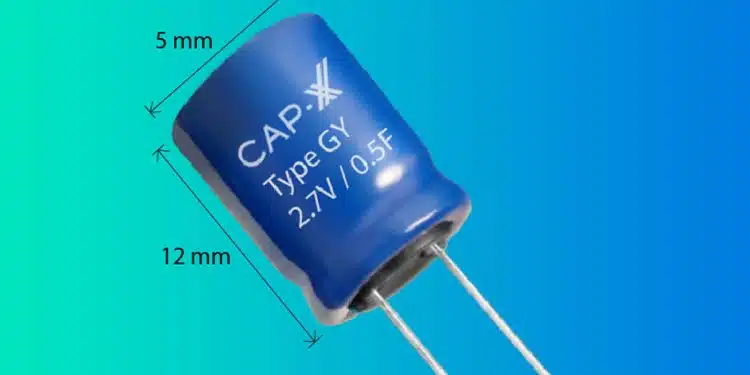CAP-XX releases ultra-small 5mm cylindrical supercapacitor to power IoT devices.
CAP-XX, the leading manufacturer of ultra-thin prismatic, cylindrical, and Lithium-Ion supercapacitors, has launched its smallest ever 5 millimetre cylindrical supercapacitor to provide high performance at low cost for IoT, medical and other space-constrained and mission-critical electronic devices. This ultra-small CAP-XX GY cylindrical supercapacitor delivers high peak pulse power of .5 Farad to devices for only US$0.15 in large volumes.
Available in single-cell (2.7V) or dual-cell (5.4V) versions, the 0.5 Farad GY supercapacitor measures 5 millimetres in diameter and 12 millimetres long, operates from -40°C to +65°C, and can be configured in series to achieve the required application voltage. Assembly is by soldering or welding (ultrasonic, laser or spot), via radial lead, solder pin or tab.
Supercapacitors can handle peak power events, supporting batteries and energy harvesters configured to provide low-power current at maximum efficiency. This architecture allows designers to use smaller, cheaper, low-power batteries and extend their run-time and cycle life, or use intermittent ambient energy sources such as solar photovoltaic. Supercapacitors also enable ultra-quick device charging and wireless power transfer, and provide the backup needed for graceful shutdown and “last gasp” transmissions in mission-critical applications.
“Our GY 5 millimetre cylindrical supercap was developed to meet the needs of space-constrained devices used in IoT, medical and other mission-critical applications where low cost is also critical,” said Anthony Kongats, CEO at CAP-XX.
Features
- High pulse power capability
- Low ESR
- Low leakage current
- Long life (IEC62391)
- Meets environmental standards for disposal and operation (RoHS)
Applications
- Energy harvesting for wireless sensors, wireless HVAC sensors and actuators
- Peak power support for GSM/GSR transmission, locks and actuators, and portable drug delivery systems
- Last gasp power for remote meter status transmission
- Short term bridging power for battery hot swaps
































